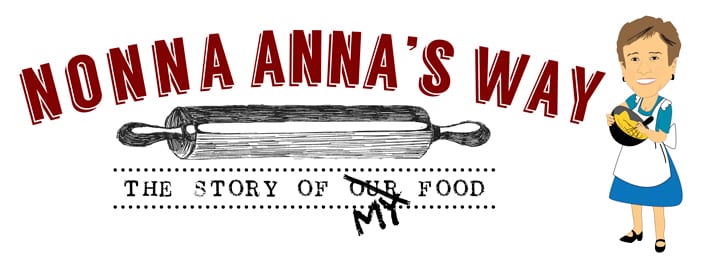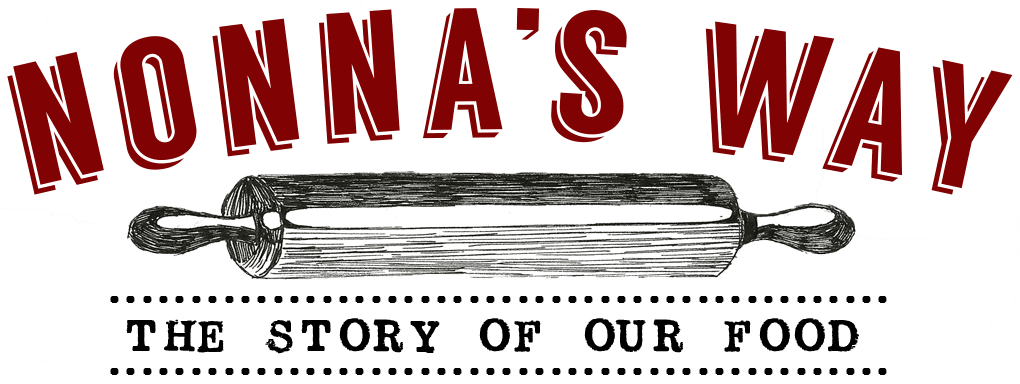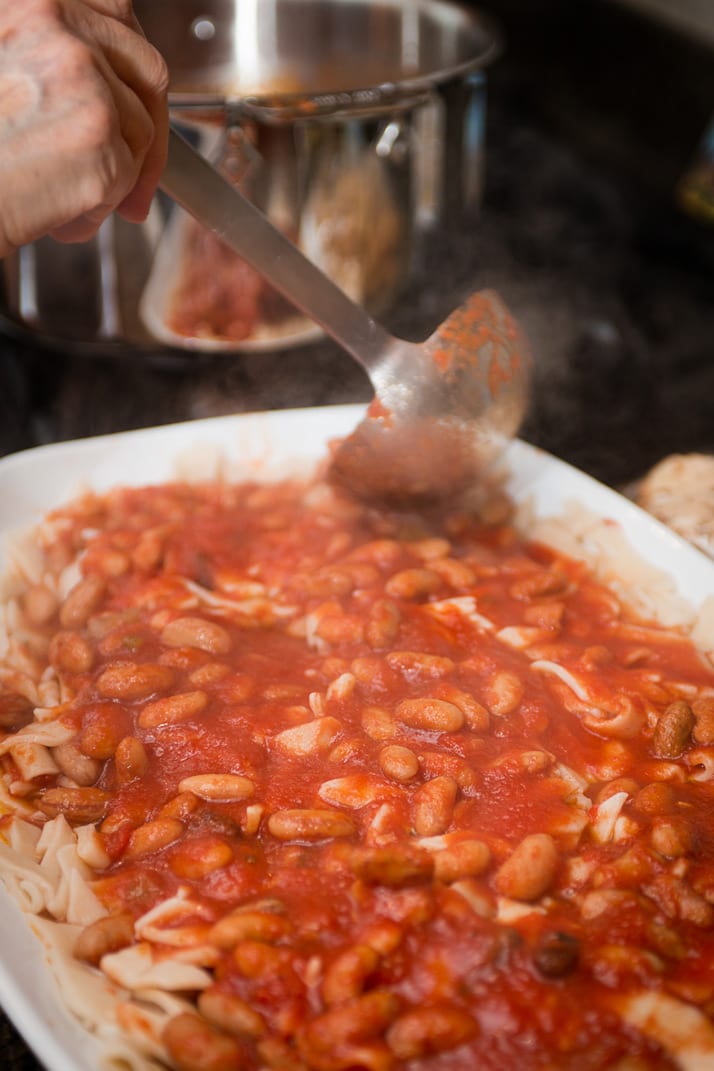Pasta e Fagioli, Pasta and Beans

Pasta e fagioli, or pasta and beans, is another classic dish found in any Italian household. Like many of the dishes that are now popular around the world, this was once a peasant dish in Italy. A very simple dish that is high in fibre and filling just on its own. The preparation of pasta e fagioli varies greatly throughout Italy as each region and town would use their most available ingredients but the two ingredients that always remain the same are cooked beans and some sort of short pasta.
During a bit of a long car ride with my mother this week (Nonna Caterina), I was asking her what she recalls of this dish growing up in Italy. She said this was made often as you could cook up a large amount which was important as they would have to feed not only their own large families but those that came to help work the land. It had to be something hearty and filling with readily available ingredients and of course not expensive to make. I then asked about the availability of flour and I loved listening to her tell me about what they needed to do so they could have flour on hand back then. She recalls how they would grow their own wheat, harvest it, take the grain to be milled then store the left over parts of the plant as feed for the animals. I find myself thinking often about how back in their impoverished times, all of our parents and grandparents had to work so hard to gather the basic necessities to survive. Contrast how much we have today compared to how frugal they needed to be, I tell myself all the time how amazingly lucky we are because of our parents’ hard work and determination. I encourage everyone to talk to their aging parents and/or relatives and record these precious stories to pass on to your kids.
Nonna Anna showed us her version of pasta e fagioli which uses the beans to make a sauce and she uses a special cut of homemade pasta called ‘maltagliati’ or ‘badly cut’. See the short video on how to cut these by hand.

Nonna Anna used home grown beans from their garden for this but you can easily replace these with canned or dry beans that have been cooked.
My dad (Nonno Giovanni) recalls as a youngster that when it was pasta e fagioli for dinner, they would serve it up in long wooden platters. Everyone would have their assigned seats around the table and you would eat right from the platter BUT be sure not to start diving in to your closest sibling’s portion! He also remembers that some would widen the tines on their forks in the hopes of grabbing more pasta with each bite! Sibling rivalry at its best back then.
But I get it because this pasta is sooooo delicious, it takes a lot of willpower to stop eating it!
Print
Pasta e Fagioli, Pasta and Beans
Description
A traditional peasant food in Italy utilizing the commonly grown romano or pinto bean, short pasta and sauce.
Ingredients
- Pasta
- 3 cups all purpose flour + extra for work surface
- 1 cup water
- 1 large egg
- Sauce
- 2 litres canned tomato puree
- 1 medium onion, cut into pieces
- 1 celery stalk, cut into pieces
- 1 carrot, cut into pieces
- 1 tablespoon olive oil
- salt and pepper
- 2 pounds pork hocks (see below for preparation)
- 2 beef shanks (cut and dice meat into bite size pieces, discard bone and fat, boil shank meat in water for 2 minutes, drain, then rinse well)
- 2 cans romano beans or equivalent fresh from garden
- or frozen
- Parmesan cheese for sprinkling on top of the cooked pasta
Instructions
To make the pasta
- With a fork beat the egg in a measuring cup. Then add water to a final volume of 1 cup.
- Make a well with the flour on your work surface, add the liquid to the center and with your hands carefully incorporate the flour into the liquid working from the inside out and being careful not to break the well wall.
- Slowly incorporate all the flour and knead until you have a very smooth dough.
- Wrap in food safe plastic wrap and place in refrigerator for 30 minutes.
- Using a pasta rolling machine, roll small portions of dough at a time until you reach a thickness of about 2-3mm. Lay the rolled sheets of pasta on lightly floured and food safe cardboard, parchment paper or a clean tablecloth to dry. Because it is thicker, it will take a little longer to dry. Once it is dry enough that it doesn’t stick to itself, fold it to a 1 inch wide roll. Start at one end and with a knife cut small diagonal pieces (see video). Separate pasta by fluffing with hands and place on cookie sheet or cardboard until you are ready to use.
To make the sauce
- Heat about 1 tablespoon of olive oil in a large pot. Add the onion, carrot and celery pieces and sauté for a few minutes.
- Add the tomato puree and salt and pepper to taste.
- Add the prepared shank meat to the pot and allow to cook in the sauce.
- Let the sauce come to a boil, then cover and gently simmer for 2 hours. Stir often.
- Thoroughly clean and then boil the pork hocks separately in water until the meat comes away from the bone. Discard the bones and any visible fat, dice the meat into small pieces and set aside.
- If using canned beans, drain and rinse well then set aside. For frozen beans, cook them separately in salted boiling water for about 30 minutes then drain and set aside. You want them firm but cooked through.
- About 15 minutes before the sauce is finished, put about a cup of sauce in a pot with the cooked diced pork hocks. Gently heat through over low heat.
- In a separate pot, do the same with the beans. Do not overcook or they will get mushy.
- Discard the onion, carrot and celery pieces in the sauce.
- Cook the pasta in plenty of salted boiling water being careful not to overcook.
- Drain the pasta but reserve about 2 cups of the cooking water.
- Put the drained pasta back into the empty cooking pot and immediately add as much sauce as desired and allow to cook together for a quick minute over low heat. Add some of the pasta water if too dry. This pasta is served a little more “liquidy” than regular pasta.
- Quickly transfer to a large, shallow serving dish. Add more sauce on top of the pasta, add the prepared pork hocks and beans along with parmesan cheese and serve while piping hot.





Sorry, the comment form is closed at this time.